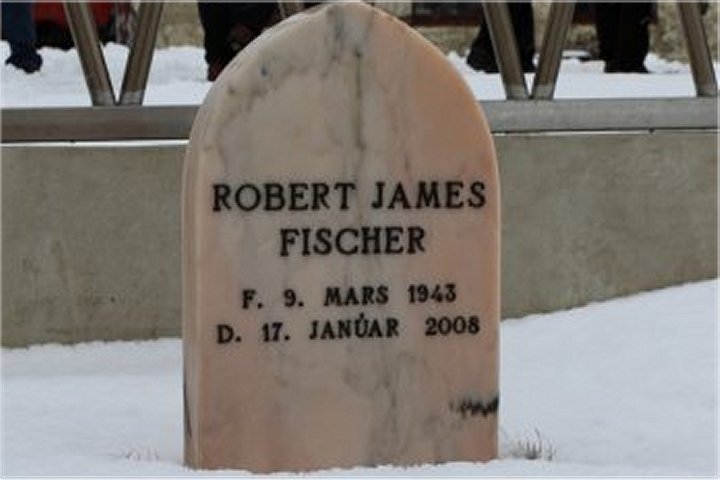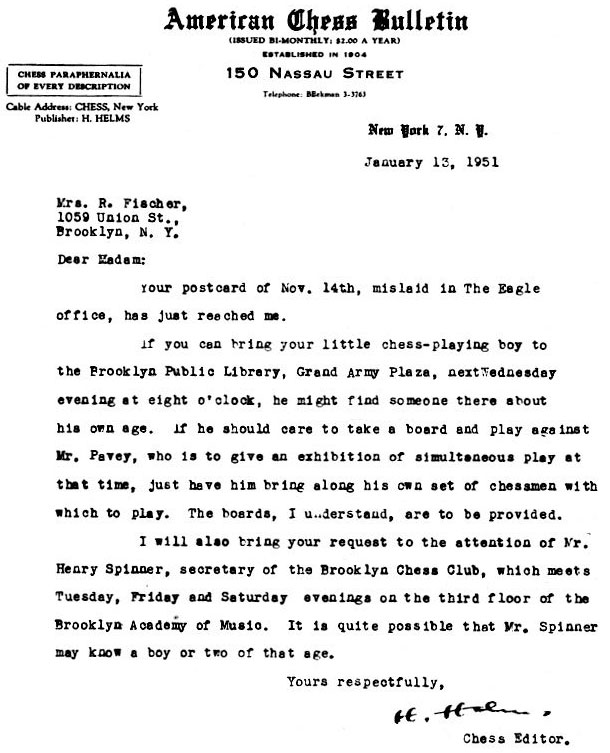


Bobby Fischer was born March 9, 1943, in the Michael Reese Hospital in Chicago. His mother Regina was poor and homeless at the time of this birth. Hans Gerhardt Fischer, Bobbys official father, had left Regina and did not provide for her and Fischer's older sister Joan. The first two years after Fischer's birth Regina was travelling with her two children through the U.S. to seach for work until she finally settled in New York in 1945.
Regina Fischer had to work to provide for herself and her two her children and Joan and Bobby were often alone. One day, when Fischer was six, his sister brought a small plastic chess set back home and he learned to play. Soon, he was fascinated by the game and his mother was trying to find appropriate opponents for him. In November 1950, she sent a postcard with an ad, in which she sought people willing to play chess against her son, to the New York daily Brooklyn Eagle. However, the newspaper did not want to print the ad and did not quite know what to do with the postcard. But in January 1951 it reached Hermann Helms, the "Dean of American Chess", and author of the chess column in the Brooklyn Eagle.
Helms promoted chess whenever and wherever he could, and he took time to answer Ms. Fischer with a friendly letter. In this letter he drew attention to a simul the American Master Max Pavey would give "next Wednesday evening" in the Brooklyn Public Library, Grand Army Plaza, at eight o'clock.

Hermann Helms' to Regina Fischer
Helms’ letter is dated on January 13, 1951, a Saturday. Four days later, January 17, 1951, Fischer and his mother came to the library and Bobby played the first public game of his life. Fischer's biographer Frank Brady describes this simul in Endgame:
A crowd of spectactors gathered around the board as the diminutive Bobby faced the self-assured, tweed-jacketed Max Pavey. The boy was so serious about what he was doing that the game attracted more and more onlookers. He kneeled on his chair to get a more panoramic view of the pieces. ...
The master was too strong. In about fifteen minutes, puffing on his pipe, Pavey captured Bobby's queen, thereby ending the game. He graciously offered his hand to the boy and with a gentle smile said, "Good game." Bobby stared at the board for a moment. "He crushed me," he said to no one in particular. Then he burst into tears. ... He later admitted that the game had a great effect in motivating him.
One spectator at the exhibition that evening was Carmine Nigro, a short, bald man in his early forties. ... Nigro studied the Pavey-Fischer game intently. He liked the moves that Bobby were making. They weren't scintillating, but they were sensible ones, especially for a beginner. With utmost concentration, Bobby seemed to block out everything and everyone around him. When the game concluded, Nigro approached Regina and Bobby and introduced himself as the newly elected president of the Brooklyn Chess Club. He invited Bobby to come to the club on any Tuesday or Friday night. No, there would be no membership dues for the boy, Nigro assured Regina. (Frank Brady, Endgame: Bobby Fischer's Remarkable Rise and Fall - from America's Brightest Prodigy to the Edge of Madness, Crown Publishers, New York 2011, p. 17-18).
Bobby Fischer's chess career had begun.
Without this simul against the 7-year old Fischer, probably only a few people would remember Max Pavey though he was very strong player. He was born March 5, 1918, and and at the end of the 1930s he studied medicine in Glasgow, Scotland. In June 1939, just before World War II broke out, he went to the U.S. where he worked as a medical doctor in New York. But before leaving Scotland, he won the Scottish Championship in 1939.
In 1954, he played on board three in a match between the Soviet Union and the U.S. and lost 1-2 against Paul Keres (one win, two losses, no draws). According to Chessmetrics Pavey had a historical rating of 2549 and was the world's number 88 at that time.
Pavey died on September 4, 1957, in the Mount Sinai Hospital in New York from leukemia.
After their game in the simul Fischer and Pavey played two games in regular tournaments. The first in semifinals of the Manhattan Championship 1956.
The second game was played in the Lessing Rosenwald Tournament 1956 (in which Fischer's queen sacrifice against Donald Byrne made him famous).